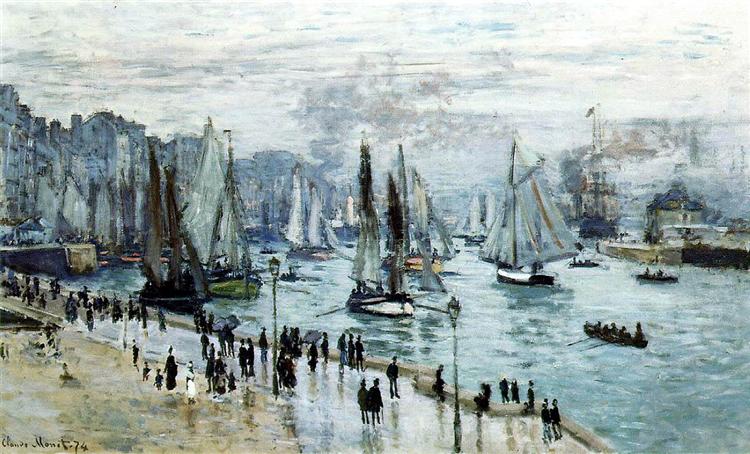Description
In "Fishing Boats Leaving the Port - Le Havre" (1874), Claude Monet invites us to immerse ourselves in an almost ethereal scene where the boundaries of reality seem to blur at the meeting of light and water. This emblematic work, a clear example of Impressionism, captures a fleeting moment in the daily life of a Normandy port, revealing both the serenity of the seascape and the vibrant activity of human beings in their relationship with nature.
The composition of the painting is a masterful play of lines and shapes that draws the eye towards the horizon. The fishing boats, depicted with loose, gestural brushstrokes, seem to come to life as they emerge from the gentle lapping of the water. The shape of the boats, with their billowing sails, together with their reflections on the surface of the sea, suggest movement and energy. The way in which Monet manages to convey the immediacy of the moment is a testament to his mastery in the use of the 'plein air' technique, which gives the work a remarkable freshness and spontaneity.
Colour plays a fundamental role in the atmosphere of the piece. Monet uses a heightened palette of both blue and turquoise for the water, while shades of grey and beige describe the harbour and the boats. Light, a recurring theme in Monet’s work, is a silent protagonist here; the way it disperses and reflects off the water gives the surroundings a sense of vitality. The mist that seems to envelop the boats and the outline of the harbour suggests the presence of Le Havre’s signature fog, a distinctive feature of many of Monet’s landscapes.
Despite the absence of prominent human figures in this work, the context is set in a space where human and natural interaction is evident. The more than likely activity of the sailors, added to the warmth of the environment, suggests a latent story behind the composition. Monet has the ability to evoke absence as a presence, making the viewer question the lives of those who would be operating on these ships.
"Fishing Boats Leaving the Port - Le Havre" was painted at a significant period in Monet's career, a time when he was beginning to establish his own style, which sought a more authentic and personal representation of the visual experience, moving away from the formalisms of academic art of the time. This work shares thematic affinities with others in his port series, where journeys in the changing light and reflection of the water are constant explorations. There, the port becomes a microcosm where light, color and emotion merge in a poetic dance.
The impact of this painting lies not only in its immediate visual appeal, but also in its ability to convey an emotional experience. Monet, through his particular use of light and color, offers us not just a painting, but a moment caught in time, a melting pot of everyday experiences transformed into art. Thus, "Fishing Boats Leaving the Port - Le Havre" stands as a pivotal work in the deepening of the language of Impressionism, a reflection of Monet's relentless search to capture the ephemeral essence of the life that surrounded him.
KUADROS ©, a famous painting on your wall.
Hand-made oil painting reproductions, with the quality of professional artists and the distinctive seal of KUADROS ©.
Painting reproduction service with satisfaction guarantee. If you are not completely satisfied with the replica of your painting, we will refund 100% of your money.

